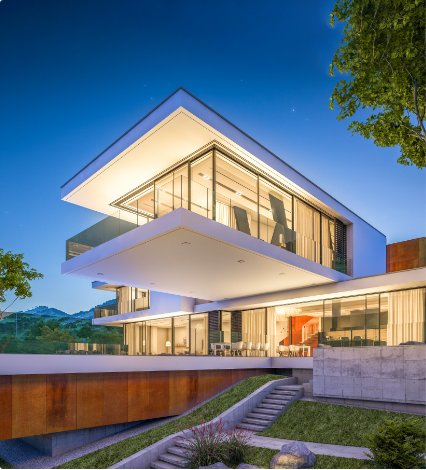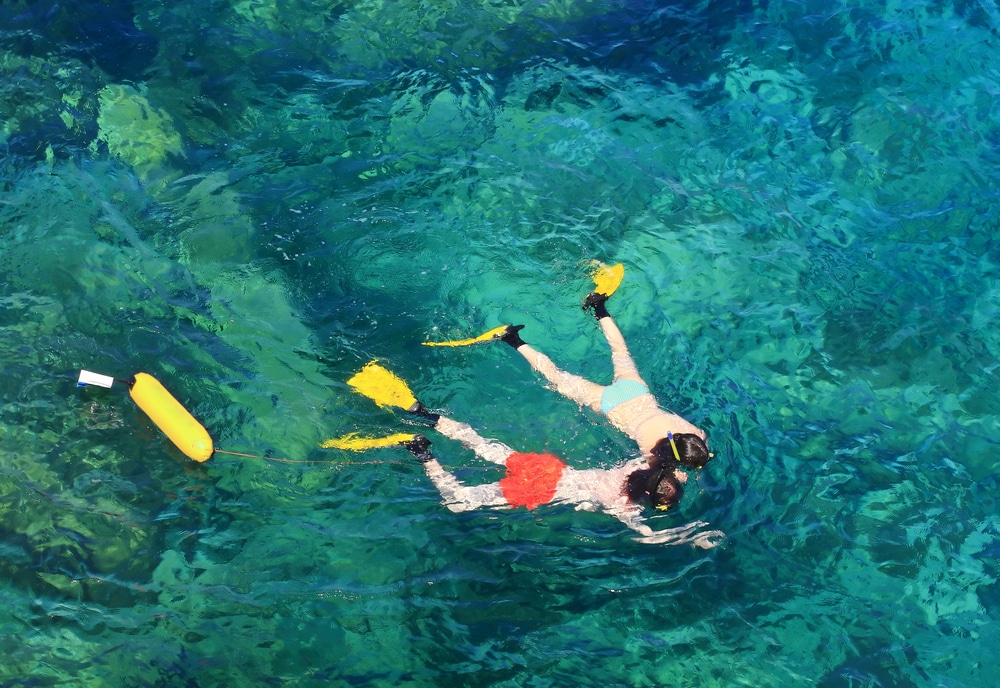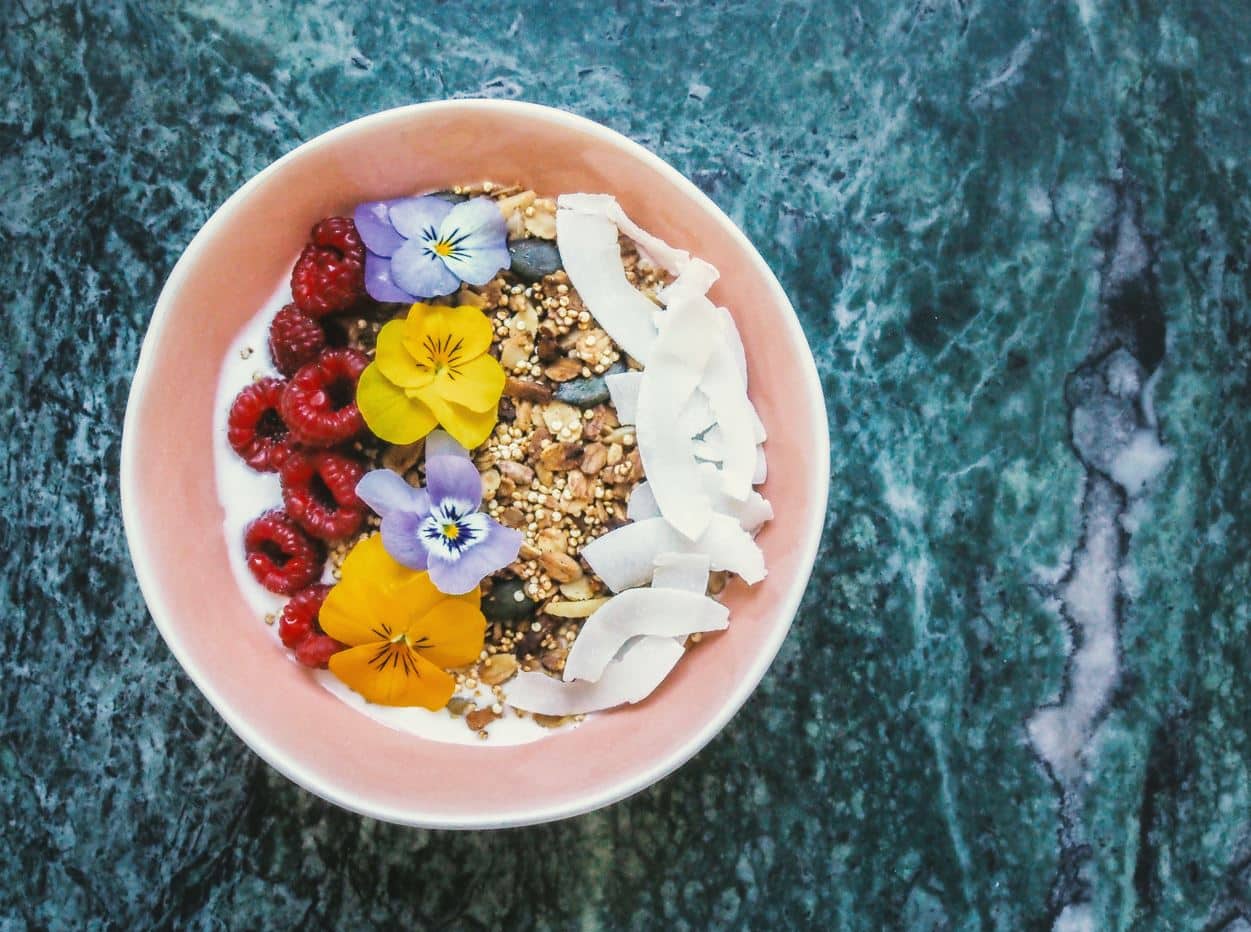Maui, the “Valley Isle” is the second-biggest island in the Hawai’ian Islands chain. Its 120 miles of coastline hosts 30 beaches, all calling for you to get on that snorkel mask and get your face in the water to greet the marine life. Who knows what you’ll see – possibly a humuhumunukunukuapuaa triggerfish (Hawaii’s State Fish) Or maybe a migrating blue whale?
Quite possibly, you’ll just enjoy the peaceful surrender to Maui’s epic shorelines.
Formed by volcanic activity, Maui is one of the eight major islands in the Hawai’ian chain. The island’s centerpiece is its two massive volcanoes – Haleakala and Mauna Kahalawai – which watch over the island. This water lover’s paradise offers visitors consistently sunny days, epic farm-to-table eating, and of course, an azure blue ocean that is always calling.
Its rugged landscape and diverse ecosystem make it a world-class destination. In fact, the western and southern shores have some of the best beaches to snorkel from in Hawai’i. The nearby islands of Kaho’olawe, Lāna’i, and Moloka’i protect these beaches from major swells. This unique geography provides islanders with calm, warm waters and some of the Hawaiian Islands’ best snorkeling.
If you are searching for the best snorkeling in Maui, you’ll find a little bit of everything. The waters on this Hawaiian island are perfect for both beginners and experienced adventurers. Maui beaches also offer unique opportunities like whale watching, getting up close with tropical aquatic species, or octopi spotting.
With a little research on seasonal conditions, accessibility, and how to locate them, finding spots for the best snorkeling in Maui is easy. Here are 14 of the most incredible snorkeling locales on Maui.
1. Honolua Bay
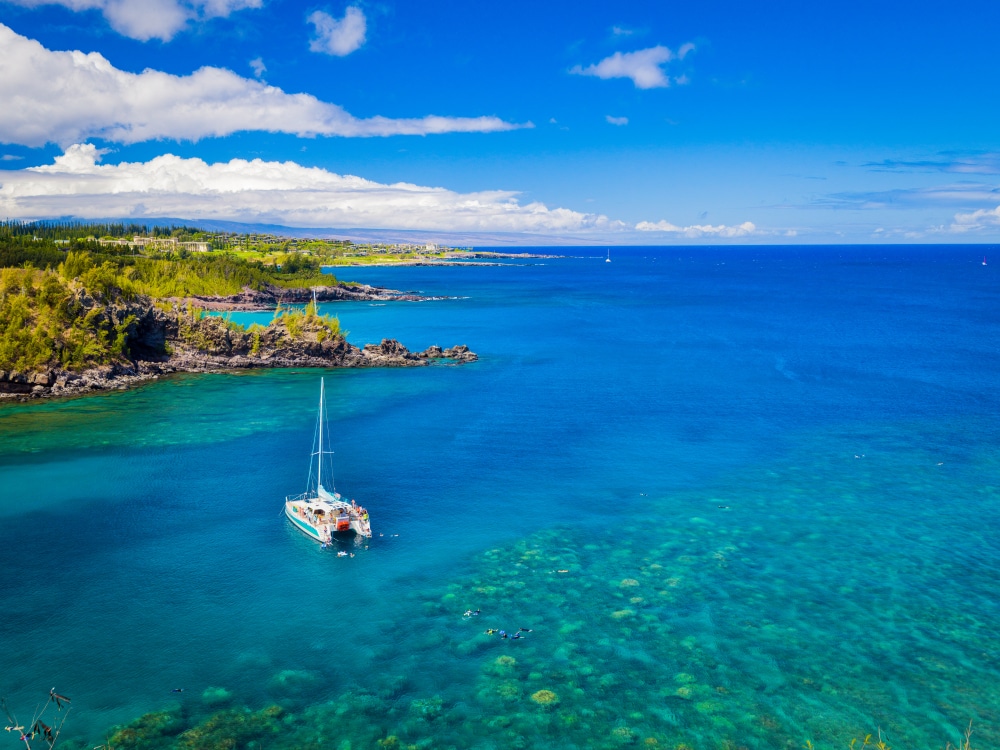
Honolua Bay sits on Maui’s northwestern coast, just north of Kapalua. Winter brings huge swells, making this beautiful beach a surfer’s paradise. However, during the summer, treacherous swimming conditions turn to clear and calm waters making this destination perfect for snorkeling.
As one of Maui’s sheltered bays, Honolua is part of the Honolua-Mokulē‘ia Bay Marine Life Conservation District. Its dense coral reef provides a refuge for colorful fish and Hawaiian green sea turtles.
The middle of Honolua Bay is just sand, and the bottom is mostly silt and small boulders. But on either side of the bay is the coral reef, with relatively shallow waters, from 10 to 40 feet. The visibility improves further from shore. While along the reef, look for coral caves and arches.
Getting There
This popular snorkeling location is easily accessed by the Honolua Access Trail off of Honoapiilani Highway. Just after the turn for Slaughterhouse Beach, you will see a parking area for the Honolua Bay Lookout.
The first access trail is just 0.2 miles further, and you’ll have a second opportunity another 0.4 miles beyond that. Follow the rocks to Kalaepohaku Point at the west end of the bay. If you are SCUBA diving, try the bay’s east side, where the water is deeper.
2. Mokulē‘ia Bay
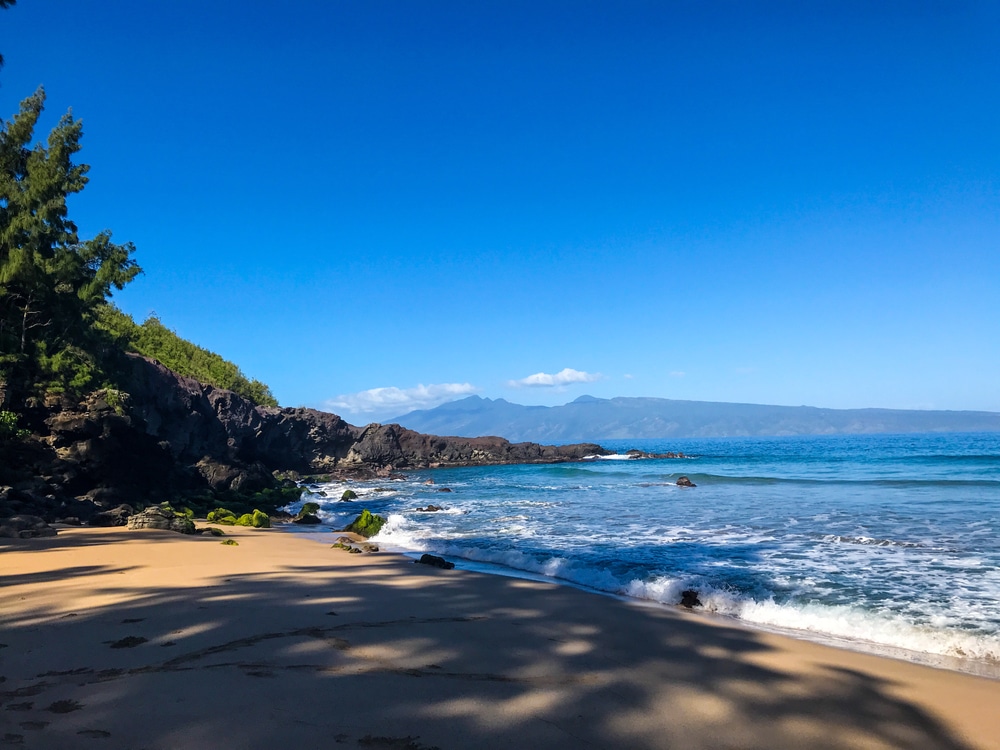
Mokulē‘ia Bay, also known as Slaughterhouse Beach, is directly south of Honolua Bay. Once part of Honolua Ranch, it is now overseen as part of the Honolua-Mokulē‘ia Bay Marine Life Conservation District.
A cozy bay, Mokulē‘ia Beach, is protected by lava cliffs and boulders. It also has right and left outcroppings – right and left points. For the best snorkeling, walk in on the north side of the beach. The bottom of Mokulē‘ia Bay is mostly sand. To the left are lava fingers. While this is a great spot, everything worth seeing is to the right, including sea turtles, parrotfish, cornetfish, and needlefish.
With depths ranging from five to 30 feet, the coral growth in Mokulē‘ia Bay is impressive. The best time to snorkel at Mokulē‘ia Beach is spring, summer, and fall. During the calmer summer waters, it is possible to snorkel from Honolua Bay to Mokulē‘ia Bay. Intermediate to advanced snorkelers should enter the water on the right side of the beach.
Getting There
Getting to Mokulē‘ia Bay is relatively easy. If you are traveling from Kapalua, it is a short drive on Honoapiilani Highway, past the resort zone. The beach at Mokulē‘ia Bay is beautiful but has no amenities, so come prepared with snacks and snorkeling gear. Parking is limited on the makai – the ocean side of the road. And there is a long flight of cement stairs to get to the beach. Once there, it’s an easy walk-in water entrance into snorkeling heaven.
3. Molokini Crater
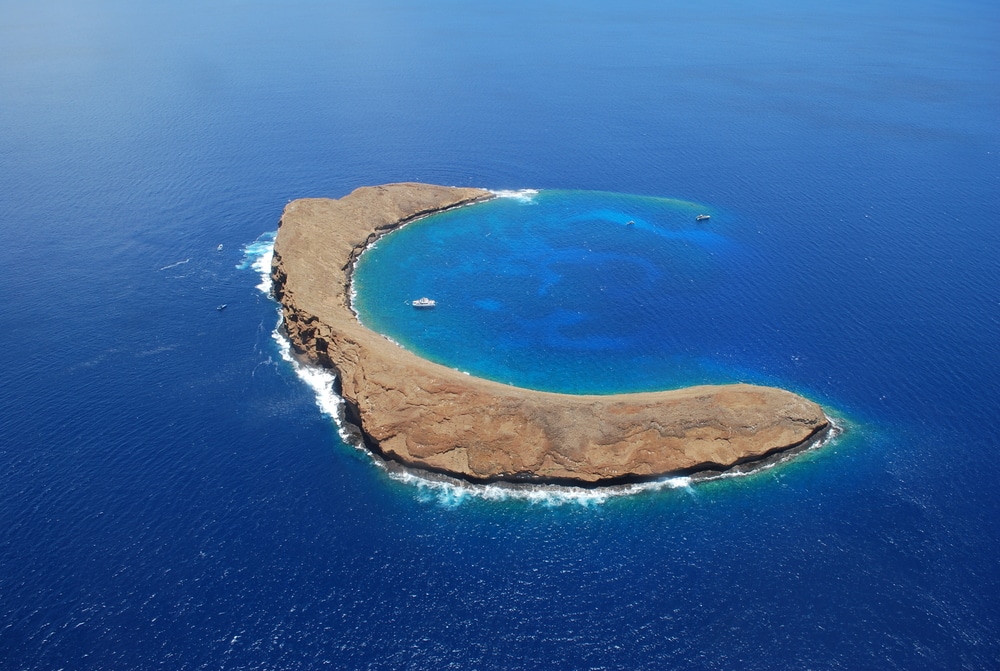
The crescent-shaped Molokini is a volcanic caldera three miles off Maui’s west coast. Older than Maui’s Haleakala Volcano, it is considered one of the world’s best scuba diving and snorkeling sites, with visibility reaching 150 feet. Ancient Hawai’ian legends describe Molokini Crater as a beautiful lizard’s tail that Pele, Goddess of Fire and Volcanoes, cut in half during a jealous rage.
The Molokini Crater is quite possibly the snorkeling experience of a lifetime. The unique topographical site draws half a million visitors annually to its coral reefs. Since there is always activity at Molokini Caldera, it is a good idea to read up on the volcanic history, expansive coral reef, and countless marine life ahead of time. On the crater’s back wall, snorkelers will find The Elevator, where adventurers can ride waves up and down without hitting the crater. Once in the water, there is much to see.
Molokini is an outing where good gear is important because you don’t want to miss a thing. There are over 50 species of plant, many endemic to the caldera. Marine life, both small and large, is plentiful in the crater. Snorkelers will see Bluefin Black and Reef Triggerfish, Manta Rays, Reef Sharks, and sometimes Hawaiian Spinner Dolphins.
Getting There
Unfortunately, the only way to get to the caldera is by private boat, a three-mile paddle, or an organized scuba and snorkeling tour. Tours typically include snorkeling, scuba diving (SNUBA), and breakfast or lunch.
Tour costs vary depending on the boat type, length, gear provided, and onboard amenities. One of the best ways to see and snorkel this amazing underwater world is on a Catamaran sailing tour. Most trips leave from Lāhainā or Malaea Harbors and last four to six hours.
4. Kahekili Beach Park
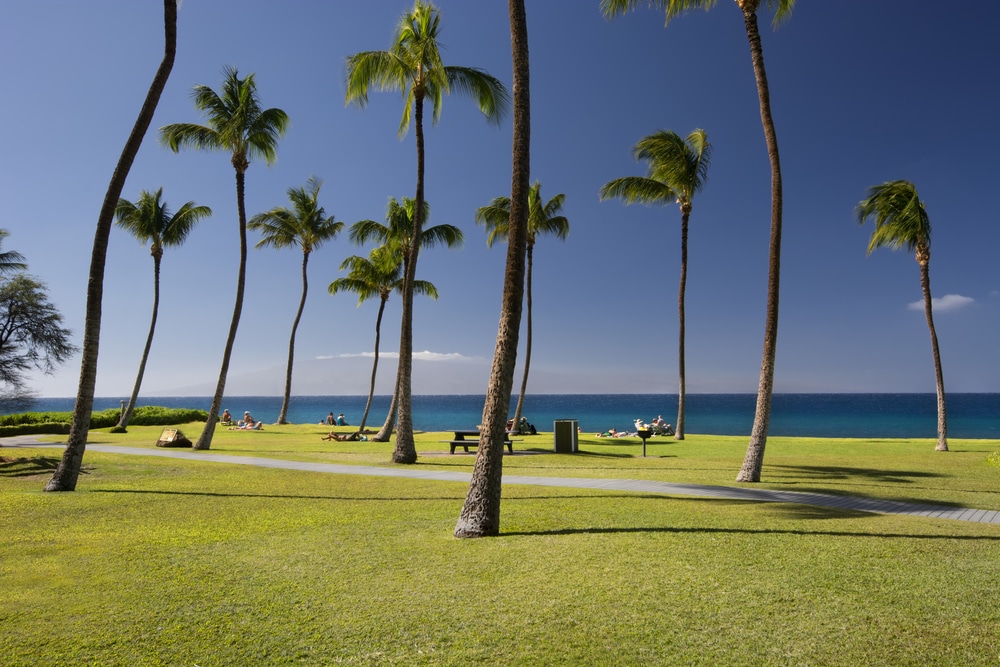
Also known as Airport Beach, Kahekili Beach Park makes for an easy day out beachfront in West Maui’s bustling Ka’anapali. The park sits at the end of Kai Ala Drive on the former site of Ka’anapali Airport and boasts one of West Maui’s longest stretches of uninterrupted beach. It is also kid-friendly and has an open green space near the beach to relax in between snorkeling. The park has basic amenities, restrooms, and a gazebo.
Because the area is part of the Kahekili Herbivore Fisheries Management Area, it is a partially protected underwater space. There are dozens of tropical fish, such as the black triggerfish and unicornfish. There are also Hawai’ian green sea turtles in these waters. And during the migration season, December through April, whalesong can be heard underwater. Kahekili Beach Park is also a favorite spot for year-round shore dives.
The snorkeling at Kahekili Beach Park is exceptional because the reef comes right up the shore, and the surf is typically calm. It is popular with families, beginner snorkelers, and less advanced swimmers. The reef is easy to find, just look for darker blue water.
Be forewarned, although this snorkel spot is convenient and has a “right in front of you” kind of access, it is not a sandy bottom. Go in carefully for the first few steps, or come prepared with water shoes.
Getting There
This spot is adjacent to the Westin Resort in Ka’anapali. This local favorite has a big parking lot making it a short stroll to access. To enter the ocean, find turquoise water and follow the sloping sand until you can float.
5. Olowalu Beach

Snorkeling at Olowalu Beach is fantastic year-round. As one of the oldest reef systems in Hawai’i, which some estimate at over 500 years old, the dense coral extends over 450 acres – earning it the name Coral Garden. To put that in perspective, the typical football field is just 1.3 acres.
This stretch of reef is one of Hawai’i’s mother reefs. The coral here spawn and send polyps as far as Lanai and Molokai, seeding those reefs as well. This one reef not only supports the coral all over the Hawaiian Islands, it is also a cleaning and feeding ground for green sea turtles and manta rays.
The shallower waters, ranging from two to forty feet, are relatively calm. While the sands at Olowalu are narrow, the underwater opportunities are amazing. The short beach allows easy access and is great for kids and beginners. Once underwater, there is plenty to see.
In addition to an awe-inspiring reef, there is great biodiversity at Olowalu, including the sea turtles, which has earned it a second moniker, Turtle Reef. Olowalu is also a favorite spot of humpback whales, with numerous sightings each winter.
Getting There
Olowalu Beach, often called Mile Marker 14, is located south of Lahaina, along Honoapiilani Highway, near, you guessed it, Mile Marker 14. It is a rustic spot with only roadside parking with no amenities.
6. Āhihi Kinau
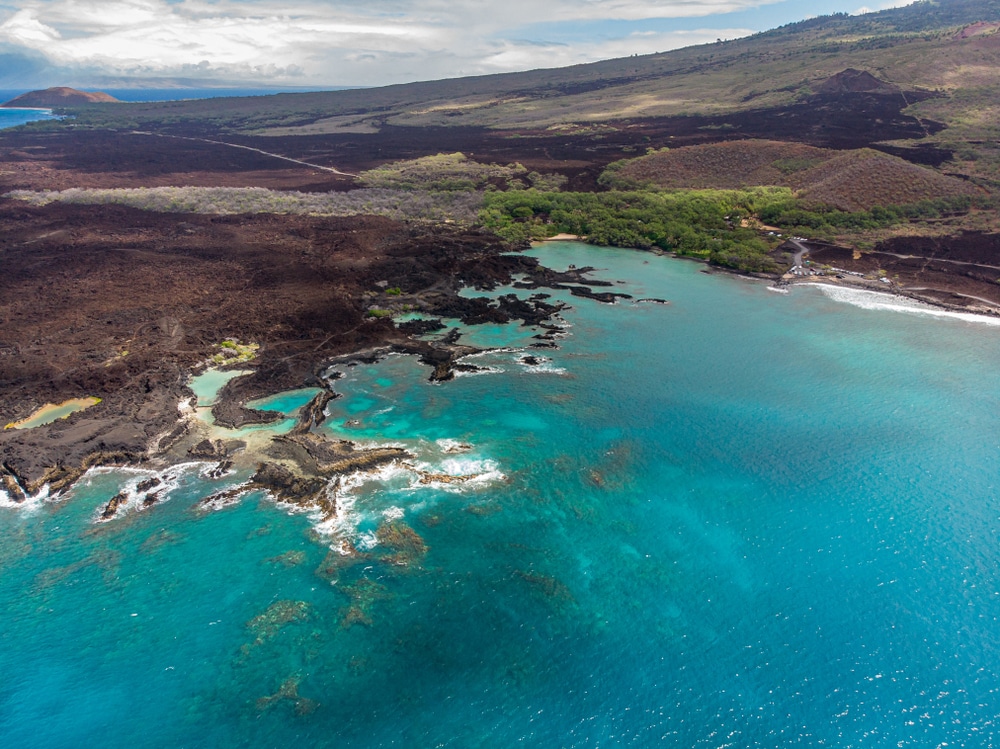
The Āhihi Kinau ecosystem is diverse. The Ahihi Kinau Natural Area Reserve is nestled between Aihihi and La Perouse Bays. It protects both sea and bird species and covers an astonishing 1,238 acres. Along the shore, anchialine ponds (a landlocked body of water with a subterranean connection to the ocean) buttress ancient lava fields to create a mind-blowing juxtaposition. Once underwater, the reef begins almost immediately.
Both the bay and the water are generally good snorkeling locations. Throughout your swim, expect to see dolphins, sea turtles, eels, and monk seals. Because it is a protected area, there is abundant fish life, including butterfish, surgeonfish, and Moorish idol.
Most of Maui has banned all but safe sunscreen. Mineralized sunscreens made with zinc oxide or titanium dioxide are considered reef safe and protect the ecosystem. There is also an entry fee To Āhihi Bay for non-residents, which helps with area preservation.
Getting There
This spot is located past the resorts on Wailea Alanui Drive in southwest Maui. However, getting to Āhihi Bay is off the beaten path and takes some driving to get to. There is a small parking lot off palm-lined Makena Road.
After parking, there is a short walking path down to the bay – only bring what you can carry. Entry is easy on the right side of the beach. A slightly submerged concrete platform makes the transition into the water effortless.
7. Kapalua Beach
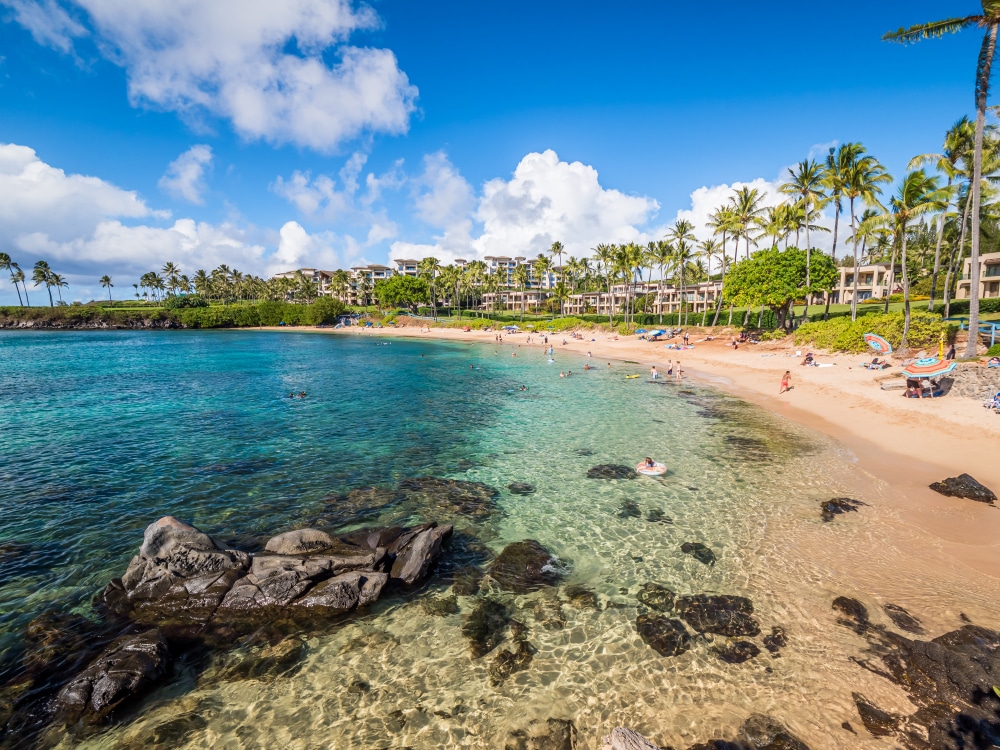
The crescent-shaped Kapalua Bay, on Maui’s upper western shore, is stunning, with some of the island’s easiest year-round snorkeling. Kapalua has great amenities, including public restrooms, outdoor showers, and even a freshwater drinking fountain.
Kapalua’s left and right points have magnificent lava rock formations – a perfect place to explore between snorkeling. In contrast, the center of Kapalua Bay is all rolling sand. The right side is ragged and shallow, close to shore, making water entry treacherous, especially when the wind and waves take over later in the day.
But on the left side of the beach, the sandy shallows are the best and safest for prepping your gear and getting the kids ready before entering the water. The waters here are generally calm, with a depth ranging from one to 15 feet, perfect snorkeling conditions for all ages and experience levels.
Once floating, the ocean floor comes alive. Many of the tropical fish are close to shore. And if you are an early riser, the left point is known for sea turtles. The right point has abundant species, including needlefish, baby parrotfish, and butterflyfish.
Getting There
Getting to Kapalua Beach is easy. It sits north of the Napili Bay Resorts on the Lower Honoapiilani Highway. There is plenty of public parking. It is also part of the Kapalua Trail System, and if you come by one of Maui’s beautiful hikes, this makes a great spot to jump in the water for a break.
8. Kamaole Beaches I, II, II
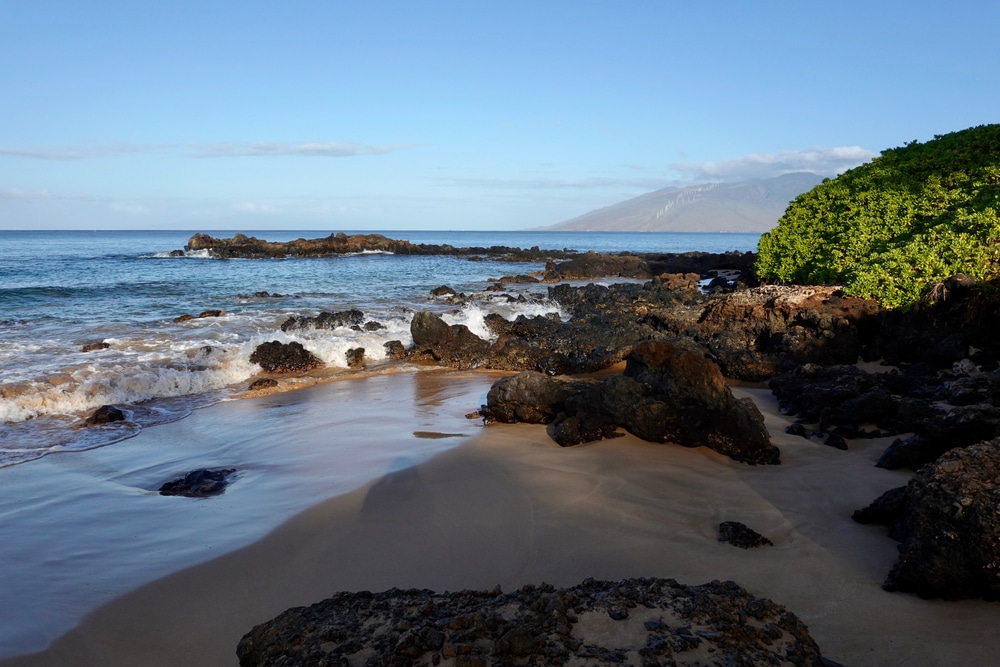
Take your pick. Any of the three Kamaole Beaches that make up the Kihei waterfront are great for families and snorkelers of all levels. Kamaole Beaches are kid friendly with safety built in. Lifeguards are regularly on patrol, and restrooms make quick changes easy.
In addition to great snorkeling, the park has volleyball pits, grills, and even playground swings if the other little ones in your group are too small to snorkel.
The three “Kam Beaches,” as they are known to locals, are separated by lava fingers – black rock peninsulas that extend into the ocean. These cool lava flows are also where the reef is densest. There is abundant marine life around the reefs here.
While there are the usual fishy suspects, there are also eels and Goldring surgeonfish. And with an eagle eye, you can spot the camouflage king – an octopus. These chimeras are known to frequent Kamaole Beach waters. The family of Kamaole Beaches is also one of the best spots in South Maui to catch a sunset.
Getting There
The Kamaole Beaches are easily accessible as they are located in the heart of Kihei on the west coast of Maui. There is plenty of public parking available, and the beaches are within strolling distance. For snorkelers, there is easy shore access to the typically calm waters
9. Ka‘anapali Beach – Black Rock
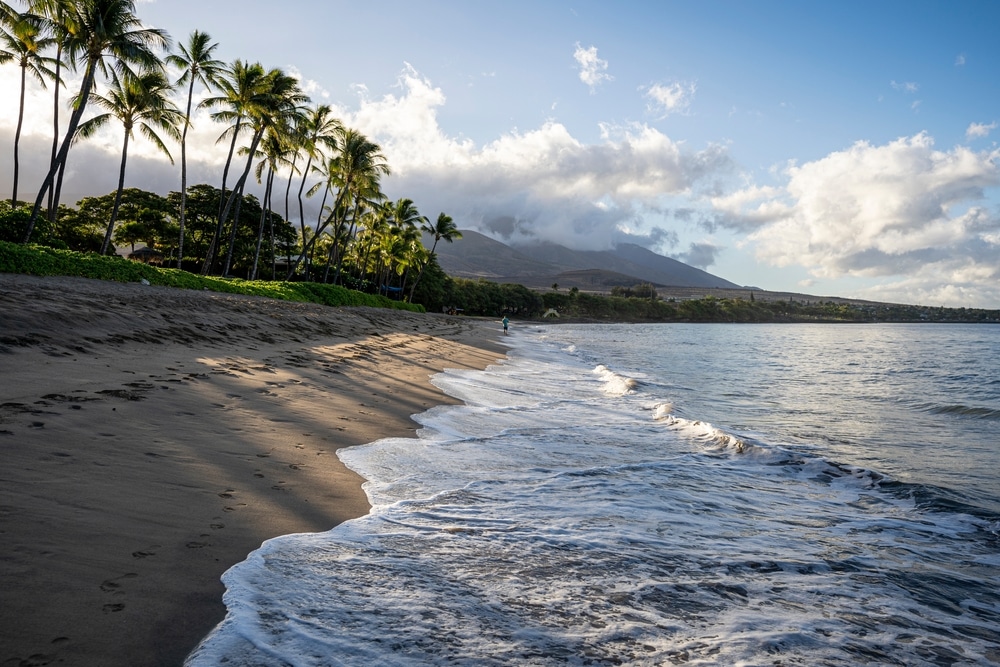
Ka’anapali Beach, known to the locals as Black Rock because of its distinctive peninsula-like black lava rock outcrop, is a popular Maui snorkeling spot. The surrounding town is widely known as one of the best areas to stay in Maui. Steeped in ancient lore, Black Rock is located at Ka’anapali Beach’s north end off of Ka’anapali Parkway.
Known to many by its Hawai’ian name Pu’u Keka’a, or Rolling Hill, this is one of Maui’s most sacred points. It is where the ancients believed that souls leaped into the afterlife. This belief is repeated throughout the islands and, in many places, honored by a nightly ritual.
Each sunset, tiki torches are lit, and a man dives into the ocean honoring King Kahekili II. If you listen closely, you just might be able to hear the whale songs as they echo off the lava rocks.
Black Rock is a fun place to snorkel and dive year-round and excellent for all ages and experience levels. Generally, calm waters with a depth range of two to twenty feet and easy shore accessibility. However, early starts are recommended as there can be a cross-current later in the day.
Near Black Rock, large schools of brown surgeonfish and goatfish float half asleep on the ocean floor. The Hawaiian green sea turtles emerge in the mornings, and the harmless blacktip reef shark makes its rounds. With luck, snorkelers can spot a large eagle ray formation. These are quite breathtaking as they move in unison. The Hawai’ian state triggerfish is also abundant here.
Getting There
Ka’anapali Beach is located on the northern tip of Maui, directly south of Whalers Village. It is in this bustling shopping area that you’ll find free parking for beach access.
10. Maluaka Beach – Turtle Town
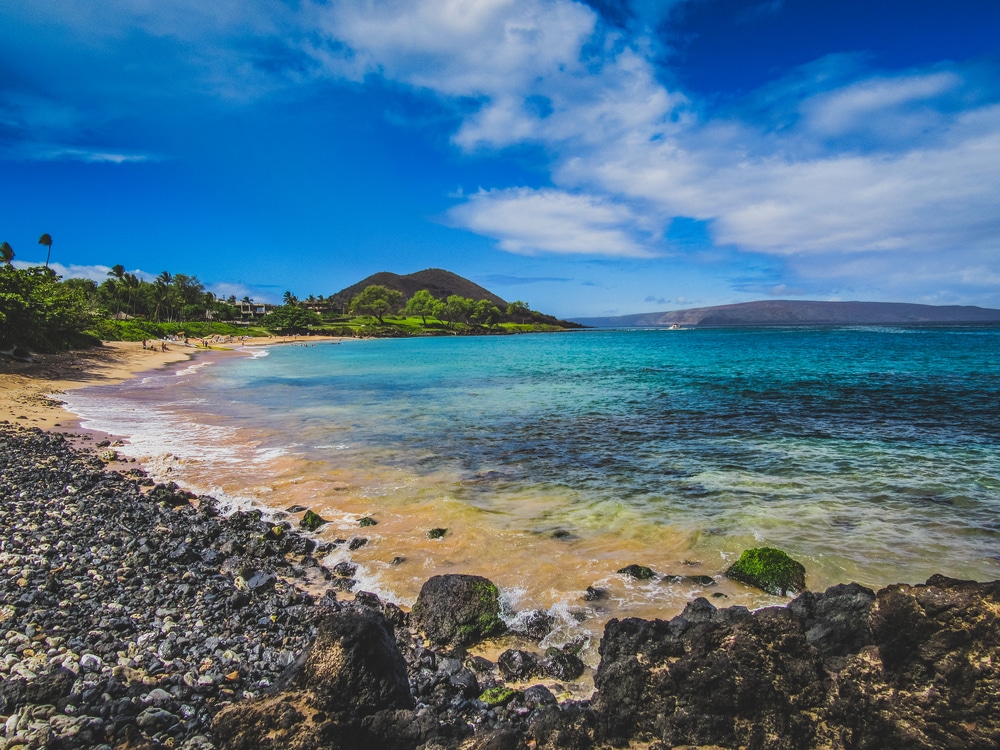
South of Wailea, between Nahuna Point and Black Sand Beach, is Maluaka Beach. This peaceful gem is known as Turtle Town for the abundance of Hawai’ian green sea turtles that feed and float near the coral reef.
Calm blue water filled with abundant tropical fish and soft white sands make Maluaka Beach a popular snorkeling spot. While underwater, expect to see chubs, beautiful bright-colored tangs. There are also schools of saddleback wrasse and sergeant majors.
This snorkeling spot is commonly used for tourist excursions. Turtle Town is a popular second stop on many Molokini Crater boat tours.
If you are new to snorkeling or want to leave the driving and gear-hauling to someone else, a day excursion may be the best bet. Boat crews are usually experienced divers and can explain the safe use of snorkel equipment.
Getting There
The Makena Alanui Highway will take you south of Wailea to Makena Landing Park. Take this access road past the park, where it will dead end at Maluaka Beach. There is also a south access road on the same road slightly further down the road past the Makena Golf and Beach Club.
11. Five Caves

Five Caves is located just north of Makena Landing Park, near Wailea, on the west coast of Maui. It is widely hailed as one of the best “walk in” options for snorkeling and scuba diving in Maui. However, this snorkeling destination may not be for everyone. It is a fantastic site for advanced swimmers, snorkelers, and scuba divers who are physically able to handle some of the natural challenges.
On the right-hand side of the breach, a small cove hides a natural lava rock step – allowing a difficult and slippery entry and exit. And it is a long, choppy swim to get out to the reef. The five caves are too deep for snorkelers but a great place to scuba dive.
Once underwater, marine life is everywhere. There are large schools of the usual suspects – unicornfish, soldierfish, goatfish, and tobies. It is also possible to see pincushion sea stars, white-tip reef sharks, and nudibranchs – vibrantly colorful gastropod mollusks. And with a sharp eye, snorkelers and divers can spot white mouth eels and scorpionfish.
Getting There
The rocky coastline of Five Caves is located along Makena Drive south of Wailea. Just south of the beach is a small parking lot. There is also a beach access path. Immediately adjacent to the path is a small graveyard, which gave rise to the site’s second moniker, Five Graves.
If you are suspicious of the hike and swim, another way to experience Five Caves marine life is on a small boat tour. Several tours offer scuba and snorkeling excursions, including Five Caves and other area beaches.
12. Wailea Beach
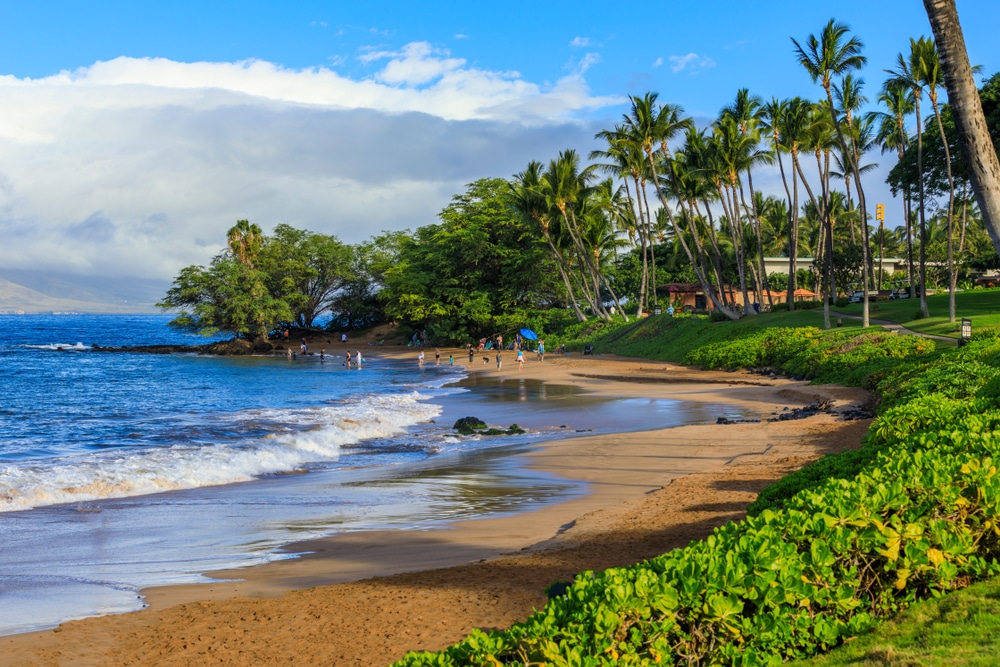
Wailea Beach, a beautiful stretch of beach just in front of The Shops At Wailea, is regularly voted one of the world’s top beaches. It is located on the southwestern tip of Maui, south of the pine-shrouded cove of Mokapu Beach and the calm waters of Ulua Beach, near the many Wailea Resorts.
This busy beach has top-notch amenities like outdoor showers, foot washing stations, and restrooms. It is in a developed area with plenty of shopping, food options, and water gear rental opportunities.
Whether you bought your gear or are using rentals, snorkeling at Wailea Beach is fun and kid-friendly, with easy shore access to the water – no pressure. Visibility at Wailea Beach is better away from shore, where the depth reaches ten to fifteen feet.
There may not be as many tropical fish or vibrant coral as other snorkel spots on the island, but there is a great compromise between water activities and beachy things. As an added bonus, in the winter, migrating humpback whales can be seen and heard from shore!
Getting There
Head to the west coast of Maui to find the bustling hub of Wailea. Once there, you’ll find plenty of parking lot options or you can stroll to the beach on the Wailea paved beach path that lines the waterfront.
13. La Perouse Bay
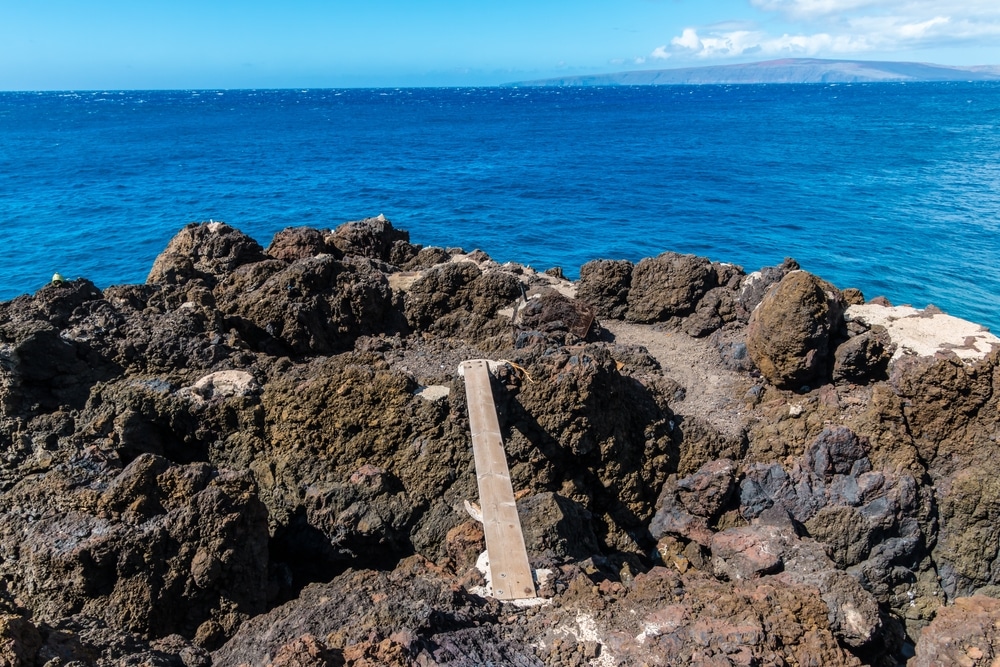
La Perouse Bay was formed by Haleakalā’s late 18th-century eruption. This beach’s terrain is similar to”Āhihi bay, surrounded by crumbling lava rocks, known as a’a. The juxtaposition between the black lava fields and bright green vegetation gives it a wild and rugged feel.
La Perouse Bay frequently sees rougher waters due to its location. That isn’t to say that it doesn’t offer great snorkeling opportunities, you just have to know when to go. Early morning activity is best. Even when the waters are calmer, they often see mediocre visibility.
This is an adventurous snorkeling location. There is still plenty to see, and the upside is that the beach is tranquil and uncrowded. The coral bed is offshore – requiring a swim to get out into the deeper water. As an added bonus, this location is a known home for a Hawaiian spinner dolphin pod.
Although a beautiful outing, La Perouse Bay is not for novice snorkelers or weak swimmers. And this beach is not kid-friendly. For those experienced snorkelers and their buddies, La Perouse can be an adventure.
Getting There
To get to Kihei and La Perouse Bay, head south from Āhihi Kinau. Wailea Alanui Drive ends at La Perouse Bay – the southernmost tip of the island. The bay is the end of the road, quite literally, where south Maui terminates. Look for access at Mile Marker 7 at the very end of Makena Alanui Road
There are, however, excellent hiking trails along the undeveloped coastline that will also get you to the bay. Be forewarned, there is little shade onshore, so the trek can get hot. Lots of water is recommended. Along the paths, some signs read Kapu. This ancient Hawaiian word means keep out, taboo, or sacred.
14. Baby Beach
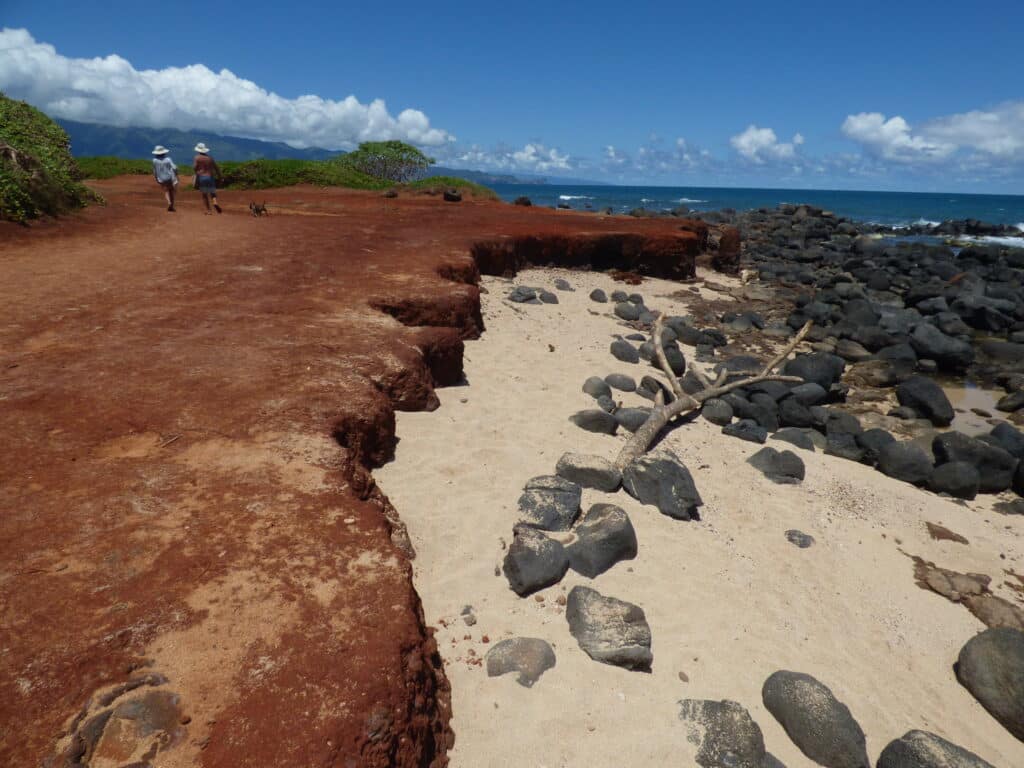
Baby Beach is a standout snorkeling destination just off Front Street in Lahaina. Given this sweet name because of its protective reefs and mellow waters, it is a great destination for families or first-timers. A broad swath of powder-fine sand and sloping entry into the water give this small beach an oasis feel while still being close to the action of the small nearby towns.
By nature of the reef being long and slightly offshore, the waves are gentle and placid. If you aren’t quite comfortable with floating with the waves, there is plenty of coral to see right as you step in. Just pop your head in with a mask, and you’re sure to catch some of the passing marine life.
In addition, just a quarter mile up shore, you’ll find the Lahaina Jodo Mission, a Japanese Buddhist Temple. The grounds are open to the public and worth the walk up the beach.
Getting There
Parking is generally available on Kenui Street in Lahaina. The path to the beach is just across from Front Street. Keep your eyes out for the recycle bins and the blue “Shoreline Access” sign. This is the beginning of the path to the beach.
Snorkel Gear
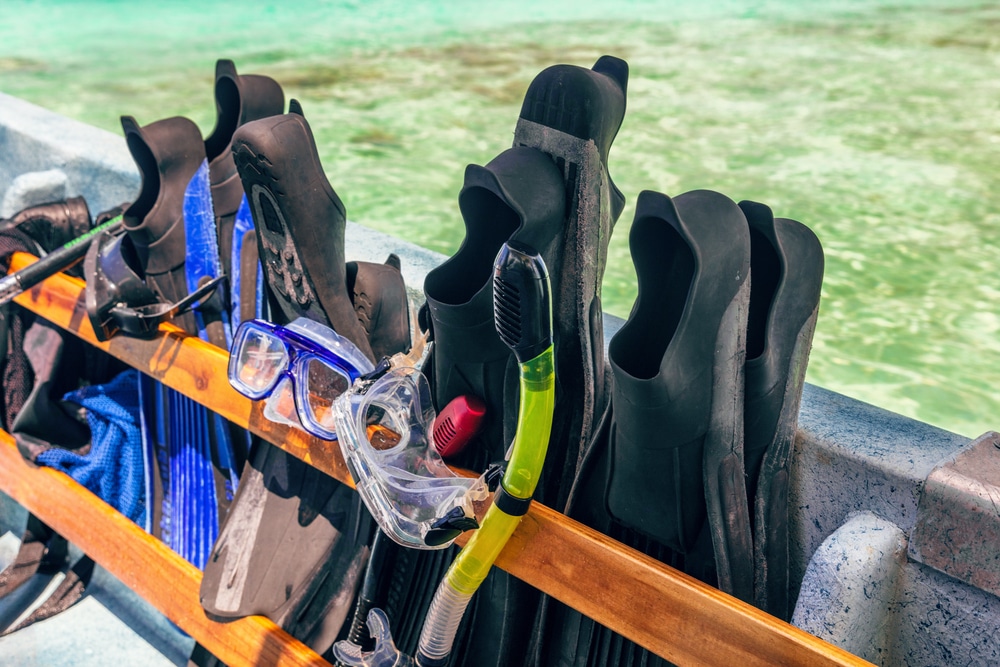
The crystal-clear water makes Maui a world-class snorkeling destination. But when snorkeling in the Pacific Ocean, knowledge of the area and proper gear – fins, face mask, and dry snorkel – is always a good idea.
When it comes to snorkeling, you have a couple of choices regarding gear. You can purchase a set at home or on Maui or rent gear. If you plan to snorkel more than once, or are unsure of your schedule, consider buying a snorkeling set.
Purchasing Snorkel Gear
Purchasing gear allows you to explore the waters on your time and ensures you have the best possible gear for your experience level. And most specialty shops on Maui will even cover the snorkeling basics, including proper use. A short-minute review is important if you are new to snorkeling or if it’s been a while since you donned a pair of fins – gear has evolved.
If you just want to purchase a cheap set, there is also safety to consider. You are in a rugged environment, not the neighborhood pool. We recommend you consider a little snorkel gear research before traveling. Unlike beach umbrellas or towels, with snorkel gear, cheaper is not always better or safer.
Renting Snorkel Gear
If you choose to rent, the island is full of specialty shops, especially around Kīhei, Lāhainā, and Ka’anapali. For a range of price and gear options, Snorkel Bob’s in Lāhainā or Boss Frog Kīhei are good bets. Alternatively, check with the concierge desks. Most larger hotels and resorts rent gear and personal watercraft for the day.
Find The Best Stays In Maui
Life can be uncertain, but there are two things in Maui that are not; great snorkeling and the tropical vacation home rental of our dreams. There is an abundance of stays available around the island, from minimal and chic to amenity-packed and ready to host a family reunion.
Check out the best stays on “The Valley Isle” on Rent By Owner.
Featured Image Credit: Studio 37
